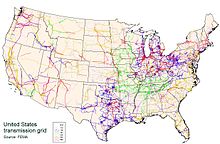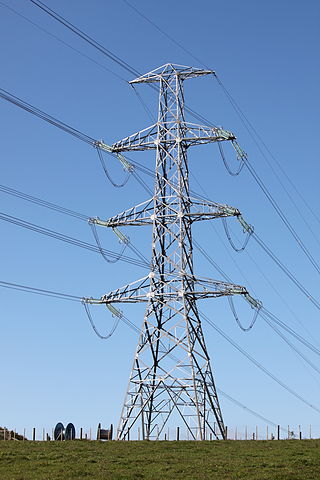
The electric power industry covers the generation, transmission, distribution and sale of electric power to the general public and industry. The commercial distribution of electric power started in 1882 when electricity was produced for electric lighting. In the 1880s and 1890s, growing economic and safety concerns lead to the regulation of the industry. What was once an expensive novelty limited to the most densely populated areas, reliable and economical electric power has become an essential aspect for normal operation of all elements of developed economies.

The Electric Reliability Council of Texas, Inc. (ERCOT) is an American organization that operates Texas's electrical grid, the Texas Interconnection, which supplies power to more than 25 million Texas customers and represents 90 percent of the state's electric load. ERCOT is the first independent system operator (ISO) in the United States. ERCOT works with the Texas Reliability Entity (TRE), one of six regional entities within the North American Electric Reliability Corporation (NERC) that coordinate to improve reliability of the bulk power grid.

A regional transmission organization (RTO) in the United States is an electric power transmission system operator (TSO) that coordinates, controls, and monitors a multi-state electric grid. The transfer of electricity between states is considered interstate commerce, and electric grids spanning multiple states are therefore regulated by the Federal Energy Regulatory Commission (FERC). The voluntary creation of RTOs was initiated by FERC Order No. 2000, issued on December 20, 1999. The purpose of the RTO is to promote economic efficiency, reliability, and non-discriminatory practices while reducing government oversight.

The Texas Interconnection is an alternating current (AC) power grid – a wide area synchronous grid – that covers most of the state of Texas. The grid is managed by the Electric Reliability Council of Texas (ERCOT).

The Eastern Interconnection is one of the two major alternating-current (AC) electrical grids in the North American power transmission grid. The other major interconnection is the Western Interconnection. The three minor interconnections are the Quebec, Alaska, and Texas interconnections.
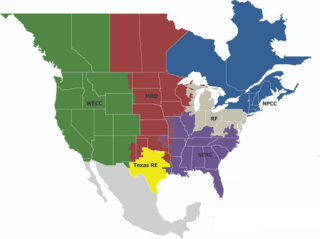
ReliabilityFirst (RF) is one of the six Federal Energy Regulatory Commission (Commission)-approved regional entities responsible for ensuring the reliability of the North American Bulk-Power System, pursuant to the Energy Policy Act of 2005. ReliabilityFirst performs this function pursuant to and under its delegation agreement with North American Electric Reliability Corporation (NERC), which is the Commission-approved Electric Reliability Organization. NERC and the Regional Entities are non-governmental, self-regulatory organizations that were created in recognition of, among other things, the complex, interconnected, and international nature of the North American Bulk Power-System.

The Western Electricity Coordinating Council (WECC) promotes Bulk Electric System (BES) reliability for the entire Western Interconnection system. WECC is the Regional Entity responsible for compliance monitoring and enforcement. In addition, WECC provides an environment for the development of Reliability Standards and the coordination of the operating and planning activities of its members as set forth in the WECC Bylaws.

The Florida Reliability Coordinating Council (FRCC) was (until 2019) one of the Regional Entities (REs) that were delegated authority to ensure reliability by North American Electric Reliability Corporation (NERC) in North America and was formed on September 16, 1996. The area served by FRCC was previously served by SERC Reliability Corporation (SERC), RE functions of FRCC were transferred back to SERC in July 2019. NERC and the regional reliability councils were formed following the Northeast Blackout of 1965. FRCC's offices were located in Tampa, Florida.

The Midwest Reliability Organization (MRO) began operations on January 1, 2005, as the successor to the Mid-continent Area Power Pool (MAPP), which was formed in 1965. MRO is one of six regional entities under North American Electric Reliability Corporation (NERC) authority. NERC and the regional reliability councils were formed following the Northeast Blackout of 1965. MRO's offices are located in St. Paul, Minnesota. MRO members include municipal utilities, cooperatives, investor-owned utilities, a federal power marketing agency, Canadian Crown Corporations, and independent power producers.

The Northeast Power Coordinating Council (NPCC) was formed January 19, 1966, as a successor to the Canada–United States Eastern Interconnection (CANUSE). It was formed in order to improve reliability of electric service. NPCC is one of six regional entities under North American Electric Reliability Corporation (NERC) authority. NERC and the regional reliability councils were formed following the Northeast Blackout of 1965. NPCC's offices are located in New York City, New York.

Southwest Power Pool (SPP) manages the electric grid and wholesale power market for the central United States. As a regional transmission organization, the nonprofit corporation is mandated by the Federal Energy Regulatory Commission to ensure reliable supplies of power, adequate transmission infrastructure and competitive wholesale electricity prices. Southwest Power Pool and its member companies coordinate the flow of electricity across approximately 60,000 miles of high-voltage transmission lines spanning 14 states. The company is headquartered in Little Rock, Arkansas.
A NERC Tag, also commonly referred to as an E-Tag, represents a transaction on the North American bulk electricity market scheduled to flow within, between or across electric utility company territories. The NERC Tag is named for the North American Electric Reliability Corporation (NERC), which is the entity that was responsible for the implementation of the first energy tagging processes. NERC Tags were first introduced in 1997, in response to the need to track the increasingly complicated energy transactions which were produced as a result of the beginning of electric deregulation in North America.
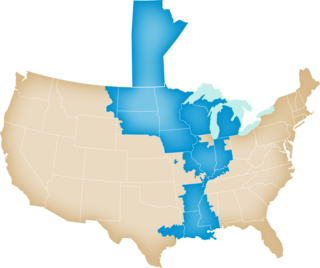
The Midcontinent Independent System Operator, Inc., formerly named Midwest Independent Transmission System Operator, Inc. (MISO) is an Independent System Operator (ISO) and Regional Transmission Organization (RTO) providing open-access transmission service and monitoring the high-voltage transmission system in the Midwest United States and Manitoba, Canada and a southern United States region which includes much of Arkansas, Mississippi, and Louisiana. MISO also operates one of the world's largest real-time energy markets. The 15 states covered by MISO are: Arkansas, Illinois, Indiana, Iowa, Kentucky, Louisiana, Michigan, Minnesota, Mississippi, Missouri, Montana, North Dakota, South Dakota, Texas, and Wisconsin.

The California Independent System Operator (CAISO) is a non-profit Independent System Operator (ISO) serving California. It oversees the operation of California's bulk electric power system, transmission lines, and electricity market generated and transmitted by its member utilities. CAISO is one of the largest ISOs in the world, delivering 300 million megawatt-hours of electricity each year and managing about 80% of California's electric flow.

The electrical power grid that powers Northern America is not a single grid, but is instead divided into multiple wide area synchronous grids. The Eastern Interconnection and the Western Interconnection are the largest. Three other regions include the Texas Interconnection, the Quebec Interconnection, and the Alaska Interconnection. Each region delivers power at a nominal 60 Hz frequency. The regions are not usually directly connected or synchronized to each other, but there exist some HVDC interconnectors. The Eastern and Western grids are connected via seven links that allow 1.32 GW to flow between them. A study by the National Renewable Energy Laboratory found that increasing these interconnections would save energy costs.
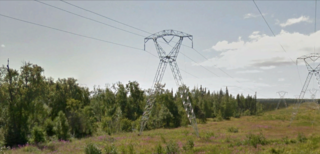
The Alaska Interconnection (ASCC) is an AC power transmission grid in North America that serves Central and Southeast Alaska. While the Alaska Interconnection is often referred to as one interconnected grid, its two parts are not connected to each other through interconnectors, nor are the two grids connected to any other interconnection, making the grids in Alaska isolated circuits. Both grids, though, are managed by the Alaska Systems Coordinating Council (ASCC) as if they were one entity like the other interconnections in North America. ASCC was formed in 1983 and is an affiliate North American Electric Reliability Corporation (NERC) member.
Electric grid security in the US refer to the activities that utilities, regulators, and other stakeholders play in securing the national electricity grid. The American electrical grid is going through one of the largest changes in its history, which is the move to smart grid technology. The smart grid allows energy customers and energy providers to more efficiently manage and generate electricity. Similar to other new technologies, the smart grid also introduces new concerns about security.
A balancing authority (BA) is an entity in the US electric system that is responsible for grid balancing: resource planning and unit commitment ahead of time, maintenance of the load-interchange-generation balance within a balancing authority area and support for real-time load-frequency control. The balancing authorities are connected by metered high-voltage tie lines and grouped into interconnections:

A regional entity (RE) in the North American power transmission grid is a regional organization representing all segments of the electric industry: electric utilities, federal agencies, independent power producers, power market operators, and end-users of the energy. North American Electric Reliability Corporation (NERC) delegates to REs authority to enforce reliability standards, collectively REs, together with NERC, are known as an "ERO Enterprise".
The power system reliability is the probability of a normal operation of the electrical grid at a given time. Reliability indices characterize the ability of the electrical system to supply customers with electricity as needed by measuring the frequency, duration, and scale of supply interruptions. Traditionally two interdependent components of the power system reliability are considered:

